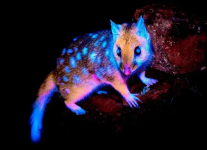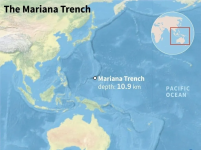’Lord of the Rings’ director backs long shot de-extinction plan, starring New Zealand’s lost moa
Author of the article:Associated Press
Associated Press
Christina Larson
Published Jul 08, 2025 • Last updated 19 hours ago • 3 minute read
Filmmaker Peter Jackson, left, and Colossal CEO Ben Lamm hold up bones from Jackson's collection of extinct moa bones in Wellington, New Zealand, 2024.
Filmmaker Peter Jackson, left, and Colossal CEO Ben Lamm hold up bones from Jackson's collection of extinct moa bones in Wellington, New Zealand, 2024. Photo by Courtesy of Colossal Bioscience /AP
WASHINGTON — Filmmaker Peter Jackson owns one of the largest private collections of bones of an extinct New Zealand bird called the moa. His fascination with the flightless ostrich-like bird has led to an unusual partnership with a biotech company known for its grand and controversial plans to bring back lost species.
On Tuesday, Colossal Biosciences announced an effort to genetically engineer living birds to resemble the extinct South Island giant moa — which once stood 12 feet (3.6 metres) tall — with $15 million in funding from Jackson and his partner Fran Walsh. The collaboration also includes the New Zealand-based Ngāi Tahu Research Centre.
“The movies are my day job, and the moa are my fun thing I do,” said Jackson. “Every New Zealand schoolchild has a fascination with the moa.”
Outside scientists say the idea of bringing back extinct species onto the modern landscape is likely impossible, although it may be feasible to tweak the genes of living animals to have similar physical traits. Scientists have mixed feelings on whether that will be helpful, and some worry that focusing on lost creatures could distract from protecting species that still exist.
A depiction is represented of the largest species of moa, the South Island giant moa, which once could stand 12 feet (3.6 metres) tall.
A depiction is represented of the largest species of moa, the South Island giant moa, which once could stand 12 feet (3.6 metres) tall. Photo by Courtesy of Colossal Biosciences /AP
The moa had roamed New Zealand for 4,000 years until they became extinct around 600 years ago, mainly because of overhunting. A large skeleton brought to England in the 19th century, now on display at the Yorkshire Museum, prompted international interest in the long-necked bird.
Unlike Colossal’s work with dire wolves, the moa project is in very early stages. It started with a phone call about two years ago after Jackson heard about the company’s efforts to “de-extinct” — or create genetically similar animals to — species like the woolly mammoth and the dire wolf.
Then Jackson put Colossal in touch with experts he’d met through his own moa bone-collecting. At that point, he’d amassed between 300 and 400 bones, he said.
In New Zealand, it’s legal to buy and sell moa bones found on private lands, but not on public conservation areas — nor to export them.
The first stage of the moa project will be to identify well-preserved bones from which it may be possible to extract DNA, said Colossal’s chief scientist Beth Shapiro.
Those DNA sequences will be compared to genomes of living bird species, including the ground-dwelling tinamou and emu, “to figure out what it is that made the moa unique compared to other birds,” she said.
Colossal used a similar process of comparing ancient DNA of extinct dire wolves to determine the genetic differences with gray wolves. Then scientists took blood cells from a living gray wolf and used CRISPR to genetically modify them in 20 different sites. Pups with long white hair and muscular jaws were born late last year.
Working with birds presents different challenges, said Shapiro.
Unlike mammals, bird embryos develop inside eggs, so the process of transferring an embryo to a surrogate will not look like mammalian IVF.
“There’s lots of different scientific hurdles that need to be overcome with any species that we pick as a candidate for de-extinction,” said Shapiro. “We are in the very early stages.”
If the Colossal team succeeds in creating a tall bird with huge feet and thick pointed claws resembling the moa, there’s also the pressing question of where to put it, said Duke University ecologist Stuart Pimm, who is not involved in the project.
“Can you put a species back into the wild once you’ve exterminated it there?” he said. “I think it’s exceedingly unlikely that they could do this in any meaningful way.”
“This will be an extremely dangerous animal,” Pimm added.
The direction of the project will be shaped by Māori scholars at the University of Canterbury’s Ngāi Tahu Research Centre. Ngāi Tahu archaeologist Kyle Davis, an expert in moa bones, said the work has “really reinvigorated the interest in examining our own traditions and mythology.”
At one of the archaeological sites that Jackson and Davis visited to study moa remains, called Pyramid Valley, there are also antique rock art done by Māori people — some depicting moa before their extinction.
Paul Scofield, a project adviser and senior curator of natural history at the Canterbury Museum in Christchurch, New Zealand, said he first met the “Lord of the Rings” director when he went to his house to help him identity which of the nine known species of moa the various bones represented.
“He doesn’t just collect some moa bones — he has a comprehensive collection,” said Scofield.

![moa[1].jpg moa[1].jpg](https://forums.canadiancontent.net/data/attachments/28/28194-89e5f40ebadde62db13c10136a61a98d.jpg)

 torontosun.com
torontosun.com
Author of the article:Associated Press
Associated Press
Christina Larson
Published Jul 08, 2025 • Last updated 19 hours ago • 3 minute read
Filmmaker Peter Jackson, left, and Colossal CEO Ben Lamm hold up bones from Jackson's collection of extinct moa bones in Wellington, New Zealand, 2024.
Filmmaker Peter Jackson, left, and Colossal CEO Ben Lamm hold up bones from Jackson's collection of extinct moa bones in Wellington, New Zealand, 2024. Photo by Courtesy of Colossal Bioscience /AP
WASHINGTON — Filmmaker Peter Jackson owns one of the largest private collections of bones of an extinct New Zealand bird called the moa. His fascination with the flightless ostrich-like bird has led to an unusual partnership with a biotech company known for its grand and controversial plans to bring back lost species.
On Tuesday, Colossal Biosciences announced an effort to genetically engineer living birds to resemble the extinct South Island giant moa — which once stood 12 feet (3.6 metres) tall — with $15 million in funding from Jackson and his partner Fran Walsh. The collaboration also includes the New Zealand-based Ngāi Tahu Research Centre.
“The movies are my day job, and the moa are my fun thing I do,” said Jackson. “Every New Zealand schoolchild has a fascination with the moa.”
Outside scientists say the idea of bringing back extinct species onto the modern landscape is likely impossible, although it may be feasible to tweak the genes of living animals to have similar physical traits. Scientists have mixed feelings on whether that will be helpful, and some worry that focusing on lost creatures could distract from protecting species that still exist.
A depiction is represented of the largest species of moa, the South Island giant moa, which once could stand 12 feet (3.6 metres) tall.
A depiction is represented of the largest species of moa, the South Island giant moa, which once could stand 12 feet (3.6 metres) tall. Photo by Courtesy of Colossal Biosciences /AP
The moa had roamed New Zealand for 4,000 years until they became extinct around 600 years ago, mainly because of overhunting. A large skeleton brought to England in the 19th century, now on display at the Yorkshire Museum, prompted international interest in the long-necked bird.
Unlike Colossal’s work with dire wolves, the moa project is in very early stages. It started with a phone call about two years ago after Jackson heard about the company’s efforts to “de-extinct” — or create genetically similar animals to — species like the woolly mammoth and the dire wolf.
Then Jackson put Colossal in touch with experts he’d met through his own moa bone-collecting. At that point, he’d amassed between 300 and 400 bones, he said.
In New Zealand, it’s legal to buy and sell moa bones found on private lands, but not on public conservation areas — nor to export them.
The first stage of the moa project will be to identify well-preserved bones from which it may be possible to extract DNA, said Colossal’s chief scientist Beth Shapiro.
Those DNA sequences will be compared to genomes of living bird species, including the ground-dwelling tinamou and emu, “to figure out what it is that made the moa unique compared to other birds,” she said.
Colossal used a similar process of comparing ancient DNA of extinct dire wolves to determine the genetic differences with gray wolves. Then scientists took blood cells from a living gray wolf and used CRISPR to genetically modify them in 20 different sites. Pups with long white hair and muscular jaws were born late last year.
Working with birds presents different challenges, said Shapiro.
Unlike mammals, bird embryos develop inside eggs, so the process of transferring an embryo to a surrogate will not look like mammalian IVF.
“There’s lots of different scientific hurdles that need to be overcome with any species that we pick as a candidate for de-extinction,” said Shapiro. “We are in the very early stages.”
If the Colossal team succeeds in creating a tall bird with huge feet and thick pointed claws resembling the moa, there’s also the pressing question of where to put it, said Duke University ecologist Stuart Pimm, who is not involved in the project.
“Can you put a species back into the wild once you’ve exterminated it there?” he said. “I think it’s exceedingly unlikely that they could do this in any meaningful way.”
“This will be an extremely dangerous animal,” Pimm added.
The direction of the project will be shaped by Māori scholars at the University of Canterbury’s Ngāi Tahu Research Centre. Ngāi Tahu archaeologist Kyle Davis, an expert in moa bones, said the work has “really reinvigorated the interest in examining our own traditions and mythology.”
At one of the archaeological sites that Jackson and Davis visited to study moa remains, called Pyramid Valley, there are also antique rock art done by Māori people — some depicting moa before their extinction.
Paul Scofield, a project adviser and senior curator of natural history at the Canterbury Museum in Christchurch, New Zealand, said he first met the “Lord of the Rings” director when he went to his house to help him identity which of the nine known species of moa the various bones represented.
“He doesn’t just collect some moa bones — he has a comprehensive collection,” said Scofield.
![moa[1].jpg moa[1].jpg](https://forums.canadiancontent.net/data/attachments/28/28194-89e5f40ebadde62db13c10136a61a98d.jpg)

’Lord of the Rings’ director backs long shot de-extinction plan, starring New Zealand’s lost moa
Filmmaker Peter Jackson owns one of the largest private collections of bones of an extinct New Zealand bird called the moa.
![jackson[1].jpg](/data/attachments/28/28193-7a7d26e9426a896c2c87b48201b4711f.jpg)













